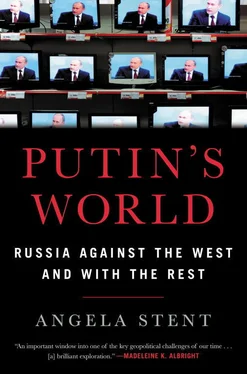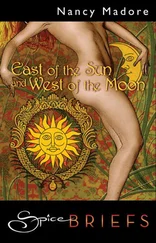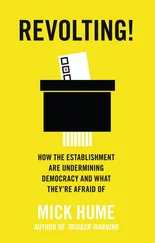SAUDI ARABIA
Eighty-one-year-old King Salman of Saudi Arabia emerged from his plane at Vnukovo Airport in Moscow in October 2017, stepped out onto the golden escalator he had brought with him, and began to descend. But the escalator malfunctioned, the king paused, and then he had to walk down the stairs, to the consternation of his security detail. Meeting him at the bottom of the stairs was Dmitry Rogozin, the brash deputy prime minister in charge of the defense industry. Later, Putin received Salman in the great hall of the Kremlin, and the leaders got down to business, signing multiple agreements. These included the Saudi purchase of Russian S-400 air-defense missiles, the transfer of several advanced Russian military technologies to Riyadh, and a Saudi pledge to invest in the Russian energy sector. The two leaders also agreed to continue their pact to keep oil production down to levels that would support oil prices and prevent further price declines. 61The king brought with him an entourage of 1,500 people plus his own furniture, carpets, chefs, and food, and the Saudis took over two of Moscow’s most luxurious hotels. 62It was indeed an impressive first visit ever by a Saudi monarch to Russia. This represented another—and a most striking—milestone in Russia’s return to the Middle East. The rapprochement between Russia and Saudi Arabia marks a noteworthy success for the Kremlin in its quest to become the region’s new power broker.
The USSR was the first non-Muslim country in 1926 to recognize what a few years later would officially become the Kingdom of Saudi Arabia, because it hoped the new state would become a leader in the anti-imperialist movement. But relations soon soured, and Stalin closed the Soviet embassy there in 1938. The Soviet diplomats who had labored so hard “to convert the Arabs to the Marxian creed” returned to Moscow, where they were promptly executed. Relations between the two countries remained cool, while US-Saudi relations flourished. In 1945, the US-Saudi relationship was cemented when President Roosevelt met the Saudi king, and the kingdom became a reliable, if sometimes difficult, US ally. Its role as the world’s largest oil exporter and the custodian of Mecca and Medina established its unique importance. Saudi Arabia worked with the United States to arm the mujahideen fighting the Soviet Union in Afghanistan. Diplomatic relations between Moscow and Riyadh only resumed after the Soviet collapse.
At the same time, the Kremlin became increasingly wary of the influence of what is called Wahhabism—Saudi Arabia’s austere form of Islam—on its restive North Caucasus. Indeed, the Saudis encouraged the growth of Islam in the post-Soviet countries, built mosques and madrasas in Central Asia, and expressed support for the Chechens during their war with Moscow in the 1990s. The Russians blamed Wahhabism for the rise in religious extremism in Russia and its southern neighborhood, and they viewed Saudi support of Islamic education in Central Asia as a potential domestic threat.
Nevertheless, Saudi Arabia was becoming more important in Russian foreign policy calculations for a number of reasons. As the leading oil producer and key player in OPEC, it had a major impact on the price of oil, and Russia’s interests as another major oil producer did not always coincide with those of Saudi Arabia, which it viewed as a competitor in global oil markets. Indeed, there are some Russians who blame Saudi Arabia for contributing to the collapse of the USSR because, they allege, it colluded with the United States to deliberately drive down oil prices in the mid-1980s. And during Putin’s tenure there were also suspicions that the Saudis flooded the market with oil to keep prices down and weaken Russia. Conversely, the Saudis from time to time believed Russia sought to sabotage both the oil market and Saudi leadership by not cutting back on its production when OPEC restricted its own. The Saudis were also a major player in the Middle East and a foe of Russia’s partner Iran, and they were suspicious of Moscow’s dealings with Tehran. Moscow’s support for an ally of Iran—Syria—even before the outbreak of the 2011 civil war, was another factor complicating the relationship.
Putin traveled to Saudi Arabia in 2007, the first Russian leader to make an official visit to the kingdom. He went there the very next day after delivering his blistering attack on the United States at the Munich Security Conference, when Russia was seeking more investment opportunities. The Saudi king welcomed him, saying, “Both countries enjoy great economic capabilities, good natural resources, numerous investment opportunities, and a distinct cultural heritage.” 63The two leaders signed a number of commercial agreements and discussed the Israeli-Palestinian problem, Iraq, and other regional issues. After that, trade grew at a modest pace, and the Saudis began to consider Russia as an alternative arms supplier to their traditional ally, the United States.
Prior to Russia’s military intervention in Syria, Saudi Arabia’s relationship with the Obama administration came under strain for several reasons. The Saudis could not understand why the United States had abandoned its long-term ally Hosni Mubarak after the outbreak of the Arab Spring in Egypt—only to facilitate the election of the head of the Muslim Brotherhood, which the kingdom had designated as a terrorist group. The Saudis were also disappointed by the US’s weak response to the uprising against Assad and its failure to intervene more decisively against the Iran-backed Syrian president. And it was suspicious of Washington’s negotiations with Tehran over a nuclear deal. Ironically, it was Syria—and falling oil prices—that drove Russia and Saudi Arabia closer together, even though Russia remains a staunch backer of both Iran and Syria. But it is precisely because the Kremlin has influence in both countries—along with its impact on oil prices—that the Saudis believed it was in their interest to improve ties with Putin in order to better understand and possibly affect Russian policies.
In 2014, oil prices began to fall from their $110 a barrel level. Russia was already suffering from financial and other sanctions imposed by the West after the onset of the Ukraine crisis. It was hit hard by both the fall in oil prices and the falling ruble. In November 2014, it refused to cooperate with OPEC to support prices. Over the year, oil prices fell to $50. But as the economic pain mounted, Moscow began to rethink its previous reluctance to coordinate production levels with OPEC and, specifically, Saudi Arabia. It had previously toyed with the idea of collaborating with OPEC but had demurred, preferring to retain sovereignty over its production decisions rather than have to debate with a group of countries how much it could produce. Its growing economic problems forced a reappraisal of its aversion to cooperation with OPEC, and in the autumn of 2016, Russia and Saudi Arabia for the first time agreed to work together to limit output and tackle the global oil glut.
In December 2016, OPEC countries, led by Saudi Arabia, and non-OPEC exporters, led by Russia, agreed on cutbacks that succeeded in raising oil prices. Putin subsequently met with the rising star and key decision-maker Deputy Crown Prince Mohammad bin Salman (MBS), describing him as a “very reliable partner with whom you can reach agreements, and can be certain that those agreements will be honoured.” 64During a visit to Moscow, the Saudis had signed memoranda of understanding to invest $10 billion in Russia—the largest single foreign investment pledge ever made. In the run-up to the 2018 Russian presidential election, it was important to sustain the Russian budget, and oil prices were a key factor. The OPEC/non-OPEC oil production agreement—bolstered by strong global demand—was renewed in 2017. Subsequently, MBS called for a ten-to twenty-year agreement with Russia to regulate oil production. 65
Читать дальше












